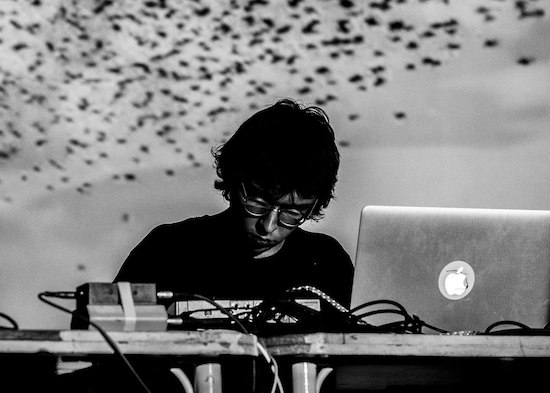"Calling this ‘a cultural dialogue’ is ridiculous", says a kind-looking bearded man, sat in front of his computer. His name is Bulat Khalilov and he is the co-owner of Ored Recordings, a label specialising in recordings of traditional Russian music, and his unforgiving video diary opens a documentary called Bonfires & Stars.
The dialogue (or otherwise) that Khalilov refers to is the trip taken by Fedor Pereverzev, the Muscovite electronic artist recording under the name Moa Pillar, to the Kabardino-Balkaria republic in the Caucasus region to attempt to work with and take inspiration from the communities there, a journey the film follows. To some audiences — and to Khalilov, Pereverzev’s guide to the Circassian culture — this seemed more like a failure, and the film seeks to explore "how blurred the lines between appropriation and collaboration are", as Mourad Moussa writes, introducing the film.
The experience, though, represented an important step for Pereverzev making Humanity, his strongest album and one of the best long-players made by a Russian electronic musician this decade. Six long, sustained tracks mix blurred noise-ambient with ramming, unrelenting techno beats. Throughout, the album is laced with samples of traditional folk music, a trait that has come to be a constant across Pereverzev’s work and that led to him being invited on the Bonfires & Stars journey.
The record remains an underrated gem, released last October on Full Of Nothing. While it was received well, Ivan Afanasyev, the label’s owner and one half of Love Cult, recent tQ interviewees themselves, says, "it still didn’t get the recognition that Fedor truly deserves." However, with the film recently screened at Switzerland’s long-running Visions du Réel festival, we took the opportunity to talk to Pereverzev, who works by day for the Russian sound-design firm Monoleak, about the film and the processes behind Humanity.
How did you feel looking at yourself in the movie?
Fedor Pereverzev: The first time I watched it in the cinema, I couldn’t sit calmly. But it was a beautiful feeling, because the movie actually affected people, and they were laughing when it was necessary. After, a woman who knew Bulat caught me in the lobby and started importuning me, saying that the project was just about selfishness and not about folklore in any way. So, she took it very seriously. But I think it’s quite clear from the movie, that it’s not about folklore at all — maybe the director was thinking about symbiosis in the very early stages of production, but that was not the issue.
What do you think about Bulat’s words at the start of the film about the dialogue of cultures not working?
FP: The dialogue of musical cultures really didn’t work, but there was a lot of human dialogue. Actually, I took a lot from this trip. I really love R. Carlos Nakai, who introduced the Native American flute to the world, and I sampled a lot of his works. I always thought it would be fantastic to show him my music and to ask him what he thinks about it. When I arrived in Kabardino-Balkaria, I talked a lot to Zamudin Guchev — he’s like Nakai there. Zamudin is 60, he raised up the local culture from nothing and all the modern local musicians are his disciples. Zamudin thinks that it’s okay to use local Circassian sounds in electronics, because it anyhow leads to its promotion. At the same time, the majority of other people reject this [idea]. These genre-crossings are not close to anyone, and after the trip I understood that I’d better stop flirting with them.
In the movie you tell Bulat that you didn’t know anything about Caucasian culture at all. Did you prepare for the trip in any way?
FP: Bulat had a very serious approach and even sent me articles about the Caucasian War. I listen to a lot of world music, and I felt that it would be important for me to do everything during the process. I could have written tracks in Moscow and simply played them in situ, so that maybe the music in the documentary would be stronger, but it wouldn’t be interesting for me at all. I wanted to put myself in a situation when one doesn’t understand anything and has to make something really fast.
So what exactly happened when you tried to collaborate with the Caucasian musicians?
FP: There was a difficulty from my side, because I was very bad at improvisation. But, as I said, my aim was to go there unprepared, and that was one of the reasons why no really great music went out of this. Another important moment is that people who I talked to really loved music they were performing, but they are very far from the modern electronic music. They didn’t quite get why we have to collaborate like this, and they weren’t interested in trying. I think they’re more exploring their own culture, researching their history through the musical process, so feeling the roots may be more important for them than the music itself. But this film was significant for them, and it was not about working with some electronic musician who they have never heard about – through this story they could promote their culture and tell the world something about it.
Do they really want to promote it?
FP: Not as artists, but what they undoubtedly want is their culture staying alive. The more people talk about this culture, the more youngsters, who might have some connection with it, are interested.
In another interview you said that while making Humanity you "learnt not to use the elements of ethnic music, but to talk in your own language". What exactly did you mean?
FP: It is more about sound characteristics. I’ve used flutes for a long time, and I was also fond of different stringed world instruments with timbres not convenient for working [with]. You either had to sample someone else’s works or you would’ve had to learn how to play something really well.
Also, I never worked on my music so thoroughly. I think it’s connected with my full-time job — when you work on a sound, matching it with the picture, it promotes perfectionism. For instance, I had about ten versions of ‘Peacewalker’. I worked in a very tight schedule, in a nine-square-metre basement without windows, mixing till 5am, then sleeping on a wooden couch, waking up after four hours and carrying on. It was hell, but it was amazing.
You’re always very much in step with the times. You were using ambient textures, ethnic field recordings and making beats when the electronic scene in Moscow was on the rise, and now four-to-the-floor is a very noticeable and essential element.
FP: I can’t say that all this is happening unconsciously. That I wake up, start creating and it unexpectedly coincides — no. Through all these steps I’m getting closer to a real understanding of myself in music, although I hope I’ll never reach a final point. On the one hand, it seems very important for me not to copy, not to repeat other people, to not too crudely or too directly use the elements someone else is focussed on. On the other hand, I really love Bonobo, and if you look at his works, he’s also looking to draw on the contemporary music scene. Some elements go, some add up.
Do you think there is anything you would definitely avoid using in your music?
FP: I knew I wouldn’t do four-to-the-floor. I just didn’t get why I needed this, it didn’t resonate with me. Three years ago in Croatia on the festival called Stop Making Sense I let some things go and started dancing. An even more important inspiration for me was James Holden’s album The Inheritors — this, and also Dday One’s tracks, had the most impact on me as a musician. In 2013, when The Inheritors was out, I didn’t know what I wanted to do with music, and I went into a maze, but this had an effect somehow.
You were awarded the Sergey Kuryokhin Contemporary Art Award in the electro-mechanics category. There’s also an ethno-mechanics category, and you say you’re very happy you weren’t nominated for that – why?
FP: I’ve already been nominated for ethno-mechanics once. I was pleased, but it was really strange to see myself around Tuvan throat singers. There were some wind instruments on my first album, Roraima, but mostly it’s made of kind songs about love on top of some juke. I like some sound, and I want to use it, but I never thought of myself as an ethnic musician. Also, recently I’ve released a split with i61 from the Russian rap community called YungRussia. The Sergey Kuryokhin Contemporary Art Award and YungRussia — I guess it’s a funny match.
You’ve previously said that you really like minimalist composers, although it’s pretty difficult to feel this in your works.
FP: I love their approaches, and among them are a lot of my favourite musicians. But for me Moa Pillar is more like a wildfire, and for them music is more like a safe harbour. I adore this harbour, but in practice, the universe keeps telling me in different ways, "If you do safe things, then okay, be happy. But that’s not what you’re here for, and I won’t help you with this. When you do what you really should do, attaboy." That’s a joke, of course, but with a grain of truth.
Humanity is out now on Full Of Nothing. Moa Pillar plays 16 Tons Club in Moscow on June 10; for full details and tickets, head here, and for further details about Bonfire & Stars, head here



